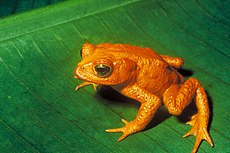Protected species
| Conservation status | |
|---|---|
 |
|
| Extinct | |
| Threatened | |
|
|
| Lower Risk | |
|
Other categories |
|
|
|
|
Related topics |
|

|
|
An endangered species is a species which has been categorized as likely to become extinct. Endangered (EN), as categorized by the International Union for Conservation of Nature (IUCN) Red List, is the second most severe conservation status for wild populations in the IUCN's schema after Critically Endangered (CR).
In 2012, the IUCN Red List featured 3079 animal and 2655 plant species as endangered (EN) worldwide. The figures for 1998 were, respectively, 1102 and 1197.
Many nations have laws that protect conservation-reliant species: for example, forbidding hunting, restricting land development or creating preserves. Population numbers, trends and species' conservation status can be found in the lists of organisms by population.
The conservation status of a species indicates the likelihood that it will become extinct. Many factors are considered when assessing the conservation status of a species; e.g., such statistics as the number remaining, the overall increase or decrease in the population over time, breeding success rates, or known threats. The IUCN Red List of Threatened Species is the best-known worldwide conservation status listing and ranking system.
Over 40% of the world's species are estimated to be at risk of extinction. Internationally, 199 countries have signed an accord to create Biodiversity Action Plans that will protect endangered and other threatened species. In the United States, such plans are usually called Species Recovery Plans.
...
Wikipedia
